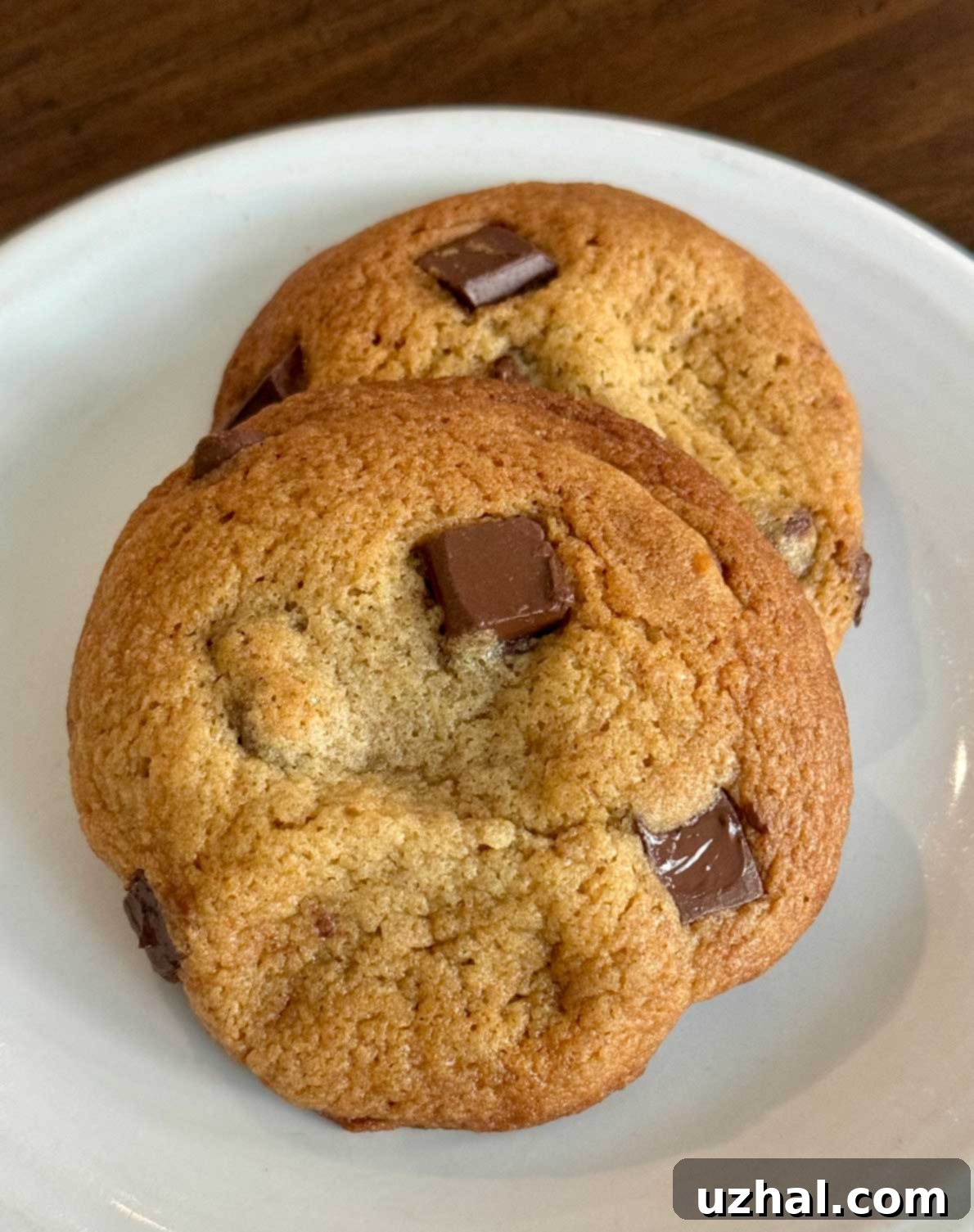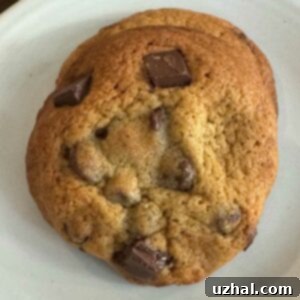Ultimate Chewy Chocolate Chip Cookies with Glucose Syrup: A Baker’s Secret
Welcome to a timeless recipe that has evolved over more than a decade! This post, originally dating back to 2010, documented my initial experiments with baking chocolate chip cookies using glucose syrup. While the early photos capture those first attempts (made with dough that hadn’t been thoroughly chilled), the recipe has since been refined, with a crucial emphasis on dough chilling. I’ve updated the article with a new photo illustrating the superior texture achieved when the dough is chilled for an extended period. This simple step significantly enhances the overall chewiness and depth of flavor, transforming an already good cookie into an extraordinary one. The core recipe remains the same, proving its enduring quality, but the technique has been perfected for optimal results.

Thirteen years have passed since I first shared this innovative recipe, and in that time, glucose syrup has become considerably more accessible to home bakers. What was once a specialty ingredient, often found only in professional baking supply stores, can now be easily ordered online or located in the baking aisle of many larger supermarkets or craft stores. If glucose syrup is still elusive, fear not! You can achieve similar fantastic results by substituting an equivalent amount of corn syrup or Lyle’s Golden Syrup. While each syrup offers slightly different nuances, they all contribute to that desirable chewy texture we’re aiming for.
The inspiration for these Chewy Chocolate Chip Cookies with Glucose came from a captivating recipe I stumbled upon on Martha Stewart’s website: her Blueberries and Cream Cookies. What immediately caught my attention was not just the unique flavor combination, but the description of their incredibly chewy texture. I was intrigued by the use of a thick syrup, which I suspected was the secret to their exceptional mouthfeel. My goal was clear: to replicate that remarkable chewiness, but within the beloved framework of a classic chocolate chip cookie. It was a delicious experiment that ultimately led to the creation of this very recipe, showcasing how a subtle ingredient swap can revolutionize a familiar favorite.

The Secret to Ultimate Chewiness: Glucose Syrup Explained
The inclusion of glucose syrup in a Martha Stewart recipe was a delightful surprise, hinting at a sophisticated baking technique. Her guest that day was a pastry chef from New York City’s renowned Milk Bar, a culinary institution celebrated for its inventive and often unexpected ingredients in classic treats. According to the chef, glucose syrup, a common component in many UK-based baking recipes, is a game-changer for cookie texture. It imparts a distinctive “better mouthfeel,” giving cookies like the Blueberry and Cream variety a fascinating duality: delightfully hard and crispy edges, contrasting beautifully with a dense, heavy, and exceptionally chewy center.
While the blueberry flavor wasn’t entirely to my personal taste, the texture of those cookies was absolutely captivating. It possessed a commercial-grade perfection—the kind you find in high-end bakeries—yet with a homemade warmth. This sparked my quest to duplicate that very texture in a chocolate chip cookie, substituting some of the granulated sugar with glucose syrup. The results were precisely what I had envisioned: thick, substantial cookies with perfectly crispy edges and an incredibly dense, satisfyingly chewy core. They boasted that sought-after commercial texture, but with all the comforting flavor of a lovingly homemade batch.
Beyond its immediate textural benefits, I observed another remarkable quality of the glucose-infused cookies: they maintained their freshness and chewiness for an extended period. Cookies baked one day tasted just as soft and delicious the next, sometimes even longer. This led me to believe that glucose syrup might act as a natural humectant and preservative, significantly contributing to the cookies’ prolonged chewiness and overall shelf life. This makes them ideal for make-ahead baking or for gifting, ensuring that every bite remains as delightful as the first.

If you’re a baking enthusiast who appreciates the finer points of cookie texture, and you happen to have some glucose syrup on hand—or are willing to pick some up from the cake decorating aisle of your local craft or specialty store—this recipe is an absolute must-try. Even if you opt for corn syrup or golden syrup, you’re in for a treat that elevates the humble chocolate chip cookie to new heights of chewiness and flavor. This is more than just a recipe; it’s an exploration into the science of baking, unlocking the secrets to a truly unforgettable cookie experience.
Crafting the Perfect Cookie: Key Ingredients and Techniques for Glucose Syrup Chocolate Chip Cookies
Achieving the ultimate chewy chocolate chip cookie isn’t just about the ingredients; it’s also about the precise techniques that unlock their full potential. For these giant, glucose-enhanced cookies, every step from mixing to chilling plays a vital role. Let’s delve into some of the nuances that make this recipe a standout, ensuring your cookies boast those coveted crispy edges and dense, chewy centers.
The Importance of Butter Temperature and Sugars
While some recipes call for cold butter, our method utilizes room temperature, softened butter. This allows for excellent aeration when creamed with the sugars, creating a light, fluffy base that contributes to the cookie’s final texture. The combination of dark brown sugar and granulated sugar is also critical. Brown sugar, with its molasses content, adds depth of flavor and moisture, which works synergistically with the hygroscopic properties of glucose syrup to ensure an incredibly tender and moist crumb. Granulated sugar, on the other hand, aids in spreading and contributes to the crispness of the edges.
The Magic of Glucose Syrup
As discussed, glucose syrup is the star here. It’s a type of simple sugar that is less sweet than granulated sugar and acts as an anti-crystallizing agent, preventing the sugar in the cookies from forming crunchy crystals. More importantly for texture, glucose syrup is highly hygroscopic, meaning it attracts and retains moisture. This is key to achieving that prolonged chewiness and keeping the cookies fresh for longer. If you’re using corn syrup or golden syrup as a substitute, they offer similar, though slightly different, moisture-retaining benefits.
Precision with Eggs and Leavening
Using a precisely measured large egg (48 grams) ensures consistency in your dough. Eggs contribute moisture, structure, and richness. Baking soda, our chosen leavening agent, reacts with the acidic brown sugar to produce carbon dioxide, helping the cookies spread and become tender. A touch of salt is essential not only for flavor balance but also to enhance the sweetness of the chocolate chips and sugars, preventing the cookies from tasting overly saccharine.
Flour and Chocolate: The Foundation and the Delight
All-purpose unbleached flour forms the structural backbone of the cookie. It’s crucial to mix the dry ingredients just until combined, as overmixing can develop too much gluten, resulting in tough cookies. And of course, no chocolate chip cookie is complete without its namesake! Semisweet chocolate chips or chunks provide the perfect balance of sweetness and bitterness, melting into pockets of gooey deliciousness throughout the chewy dough. Don’t be shy about using good quality chocolate; it truly makes a difference.
The Transformative Power of Chilling the Dough
This is arguably the most crucial step for achieving the ideal texture in these glucose-infused cookies. While you can bake them after a few hours of chilling, an overnight rest, or even better, a full 24-hour chill, will yield truly superior results. Why chill?
- **Flavor Development:** Chilling allows the flour to fully hydrate, the sugars to dissolve, and the flavors to meld and deepen. This results in a richer, more complex taste.
- **Texture Enhancement:** As the dough chills, the butter solidifies. When baked, this colder, firmer butter melts more slowly, causing the cookies to spread less and bake up thicker. This slow melting process also prevents the fats from separating too quickly, contributing to a more even bake and an incredibly chewy interior.
- **Improved Structure:** The firmer dough is easier to handle and shape, ensuring uniformly sized cookies that bake consistently.
This extended chilling period allows the glucose syrup to fully integrate and work its magic, creating a foundation for cookies with unparalleled chewiness and a delightful depth of flavor.
- Glucose Syrup Butterscotch Bars
- Milk Bar Cookbook and Confetti Cookies
- Favorite Blueberry Desserts
- Blueberry Oatmeal Cookies
- Blueberry Chocolate Chip Cookies
Recipe

Glucose Syrup Chocolate Chip Cookies
Anna
Pin Recipe
Ingredients
- 1 stick salted butter, room temperature (114 grams)
- ½ cup light or dark brown sugar (100 grams)
- 2 tablespoons granulated sugar (25 grams)
- 2 tablespoons corn syrup or glucose syrup (40 grams)
- 1 teaspoon vanilla extract
- 1 large egg (48 grams)
- 1 ¼ cups all-purpose flour (160 to 175 grams)
- ½ teaspoon baking soda
- ¼ teaspoon salt plus a pinch
- 1 cup chocolate chunks or chips
Instructions
-
In a large mixing bowl, using an electric mixer, beat together the softened, room-temperature butter with both the brown and granulated sugars. Continue to beat until the mixture is light and creamy, making sure to scrape down the sides of the bowl periodically to ensure even mixing. Beat in the corn syrup (or glucose syrup) and vanilla extract until well combined.
-
Add the large egg, beating it into the mixture just until fully incorporated. Avoid overmixing at this stage.
-
In a separate medium bowl, whisk together the all-purpose flour, baking soda, and salt.
-
Gradually add the dry flour mixture to the wet ingredients. Mix on the lowest speed of your electric mixer, or by hand, until just blended and no streaks of flour remain. Be careful not to overmix, as this can lead to tough cookies.
-
Gently stir in the chocolate chunks or chips. Divide the dough into 10 evenly sized balls. Place these dough balls onto a dinner plate lined with plastic wrap, then cover them completely with more plastic wrap. Transfer to the refrigerator and chill for at least 24 hours (or up to 72 hours for best results). This chilling step is crucial for flavor development and texture.
-
When you are ready to bake, preheat your oven to 325°F (160°C). If you have a convection oven, you can preheat it to 330°F (165°C).
-
To ensure the perfect bake time for your specific oven, consider baking just one or two cookies at a time for the first batch. Place the chilled cookie dough balls onto a parchment-lined baking sheet, leaving ample space between them. Lightly press down on the top of each dough ball to flatten it slightly.
-
Bake in the preheated oven for 16-18 minutes, or until the edges are beautifully golden brown. The centers may still appear somewhat pale and soft, but they will continue to firm up and darken as they cool. Remove the cookies from the oven and let them cool on the baking sheets for about a minute. This allows them to set slightly before transferring.
-
Carefully transfer the cookies to a wire cooling rack to cool completely. During this cooling process, the texture will transform. Initially, they might seem a bit cakey, but as the corn or glucose syrup cools, it will work its magic, resulting in that delightful crunchy edge and a dense, supremely chewy interior. For an extra touch, you can briefly freeze the cooled cookies to help set the chocolate, creating that satisfying snap when you break them open. Enjoy your perfectly chewy, homemade chocolate chip cookies!
